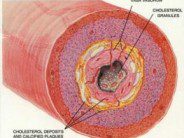Inflammation has been found to increase as humans age and contributes to the degenerative processes of aging. Inflammatory processes are thought to accelerate muscle mass loss during aging and can contribute to sarcopenia and functional decline. Accelerated inflammatory processes and chronic low level inflammation have been linked to the development of several diseases including heart disease, stroke, peripheral arterial disease, sarcopenia, neurodegenerative disorders, and depression. Cardiologist routinely measure inflammatory markers, such as C-reactive protein, to assess the inflammatory state of their heart patients. Increased C-reactive protein levels are associated with increased risk of heart disease and stroke. The inverse is also true, decreased levels of inflammatory markers are associated with decreased risk of heart disease and stroke. Physical activity has been found to decrease inflammation and this is most likely the mechanism whereby physical activity delays the aging process and protects against the cardiovascular diseases of aging. In fact, increased inflammation and oxidative stress may be the ultimate result of the traditional risk factors for cardiovascular disease such as smoking, high blood pressure, diabetes, and high cholesterol.
Researchers, lead by Dr. Mark Hamer of University College London, have found that regular physical activity during midlife results in decreased levels of inflammatory markers. The results of their study were published online in the journal Circulation. The researchers used a prospective study of 4,289 British civil servants (mean age 49.2 years) enrolled in the Whitehall II cohort study to assess the influence of regular physical activity on the level of inflammatory markers. The study participants were interviewed regarding their physical activity levels and were tested for C-reactive protein and interleukin 6, both markers of inflammation. The participants were followed for over a 10 year period and were assessed at varying time intervals throughout the study. The investigators found that those individuals who engaged in regular physical activity showed the lowest levels of inflammatory markers. In addition, those individuals who increased their physical activity levels after the start of the study also had decreases in their levels of inflammatory markers. Those who were physically inactive had the highest levels of C-reactive protein and interleukin 6.
The authors wrote, “The main findings show that physically active participants at baseline had lower [C-reactive protein] and [interleukin 6] levels and this difference remained stable over time. Secondly, maintenance of physical activity over the 10 years follow-up period was associated with lower levels of both inflammatory markers at followup. An increase in physical activity was also associated with lower levels of both inflammatory markers at follow up.” In addition the authors wrote, “Physical activity, inflammation and health are linked together in a complex fashion… the results show that physically active participants maintain lower levels of inflammatory markers over a 10 year period. Thus, physical activity may be important in preventing the pro-inflammatory state seen with aging”.
Previous studies have shown that physical activity can decrease inflammation. This is the first long term (10 years of follow up) study that shows that inflammatory markers can be decreased in midlife with physical activity. The World Health Organization recommends 150 minutes of moderate intensity aerobic physical activity for adults. This works out to be approximately 22 minutes of exercise per day. We should strive to participate in this amount of physical activity. This will allow us to maintain decreased levels of inflammation and reduce our risk of cardiovascular disease, and ultimately prolong our life expectancy by many years.
Reference:
Mark Hamer et al. “Physical Activity and Inflammatory Markers Over 10 Years: Follow-Up in Men and Women from the Whitehall II Cohort Study” Circulation Published online before print August 13, 2012, doi: 10.1161/CIRCULATIONAHA.112.103879










 DrSamGirgis.com is a blog about medicine, nutrition, health, wellness, and breaking medical news. At DrSamGirgis.com, the goal is to provide a forum for discussion on health and wellness topics and to provide the latest medical research findings and breaking medical news commentary.
DrSamGirgis.com is a blog about medicine, nutrition, health, wellness, and breaking medical news. At DrSamGirgis.com, the goal is to provide a forum for discussion on health and wellness topics and to provide the latest medical research findings and breaking medical news commentary.
{ 0 comments… add one now }